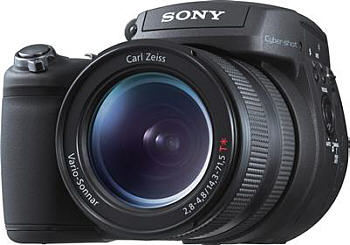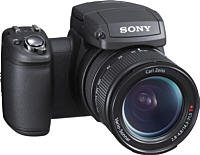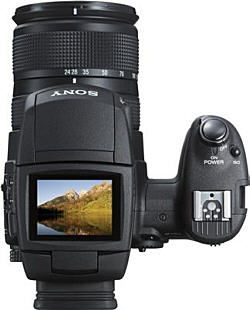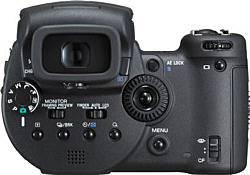Sony Cyber-shot DSC-R1 Preview

Today Sony released information on its new DSC-R1 camera, the first non-interchangable
lens digital camera with an APS-C sized sensor (the same size as used in most digital
SLRs). The DSC-R1, which is expect to retail at around $1000, has a 10.3MP sensor, a
higher pixel count than any similarly priced DSLR.
The fixed lens is a 14.3-71.5/2.8-4.8 (24-120/2.8-4.8 in 35mm equivalent terms) which
cover most of the range typically used by many photographers and both telephoto and
wideangle conversion lenses will be available.
The DSC-R1 has an electronic viefinder (no optical viewfinder) with real time display
of the image also available on the 2" LCD.
The lack of reflex viewing allows the lens to come close to the sensor, which means
that wideangle lens design is somewhat easier, though in this particular camera I'm not
sure that's much of an issue as although 24mm is wide, it's not wide enough to make design
difficult for reflex cameras.
Sony (wisely I think) included the ability to use CF memory cards as well as their own
"Memory Stick" storage media.
The DSC-R1 is neither small nor light, weighing in at around 1kg (2.2lbs) with a size
of 5.5 x 6.6 x 3.8 in (139 x 168 x 97 mm). The Digital Rebel XT with the 18-55 kit
lens weighs around 725g (1.6lb) and is 5.0 x 3.7 x 2.5 in (127 x 94 x 64 mm), though the
lens has a smaller zoom range and is slower.
The DSC-R1 is certainly an alternative to the lower end (<$1000) DSLRs and should
provide interesting competition for them. The DSC-R1 is expected to be available in
mid-November 2005.
Here's the Sony Press Release:
SAN DIEGO, Sept. 8, 2005 – Sony intends to create a new benchmark
in digital photography with the introduction of its high-end Cyber-shot DSC-R1 camera.
The Cyber-shot® R1 camera is the world’s first integrated lens digital still
camera to combine a professional-grade, 10.3-megapixel image sensor and the flexibility of
live preview while shooting. With its ultra-wide Carl Zeiss Vario-Sonnar T* zoom lens
(24mm – 120mm) and free-angle, two-inch LCD, the Cyber-shot R1 brings professional
level imaging performance to mainstream consumers.
“The R1 represents a breakthrough in digital camera technology and
construction,” said James Neal, director for digital imaging products at Sony
Electronics. “You can grab this camera and go, confident that you will be prepared
for a wide range of shooting situations. Its many convenience features and exceptional
performance can not easily be matched with a typical consumer-level digital SLR.”
A Class of Its Own
 Photo enthusiasts know that image sensor size is one
of the most important influences on picture quality. Professional-grade image sensors,
sometimes referred to as advanced photo system (APS) or APS-class, are many times the size
of compact sensors used in point-and-shoot cameras; large sensors deliver extraordinary
resolution, high sensitivity to light, and lower image noise or graininess for exceptional
pictures. At 10.3 megapixels, the R1’s sensor offers one of the highest resolutions
available in the APS class. Photo enthusiasts know that image sensor size is one
of the most important influences on picture quality. Professional-grade image sensors,
sometimes referred to as advanced photo system (APS) or APS-class, are many times the size
of compact sensors used in point-and-shoot cameras; large sensors deliver extraordinary
resolution, high sensitivity to light, and lower image noise or graininess for exceptional
pictures. At 10.3 megapixels, the R1’s sensor offers one of the highest resolutions
available in the APS class.
Unlike digital SLRs, the Cyber-shot R1 unit’s sensor allows for a “live”
preview thanks to Sony Complementary Metal Oxide Semiconductor (CMOS) technology. Until
now, the extraordinary power consumption of these large sensors has limited their
operation to image capture only – unable to support the benefit of a live preview.
Sony’s distinctive design is employed to reduce power consumption, as well as
increase image processing speeds.
The camera’s electronic viewfinder or two-inch LCD lets you evaluate scene
conditions, such as exposure and how color is rendered before taking a shot. Because the
R1 camera can preview electronically, using the image sensor itself in real-time, framing
is always 100% accurate.
Built Digital from the Ground Up
The R1’s integrated Carl Zeiss Vario-Sonnar lens was carefully crafted to take
full advantage of the resolution, clarity and color performance of its APS-class CMOS
image sensor. Because of the sensor’s live preview capability, there is no need for
the camera to have a traditional “mirror and prism” construction common to
digital SLRs. This allows a lens-to-sensor distance of as little as 2 mm, optimizing image
quality and color accuracy.
Another benefit of this structure is the ability to incorporate an extraordinary wide
field of view and zoom range. The 24 mm wide end of the lens is particularly suited for
architectural photography, landscapes and large-group portraits, while the 120 mm
telephoto end is perfect for filling the frame with distant subjects. This is a range not
easily matched by any other lens for use with cameras using large-scale image sensors.
Furthermore, no mirror and prism construction means that the R1 is a quiet camera,
perfect for shooting at a tennis match or in nature without disturbing wildlife.
 Get the Shot without the Backache Get the Shot without the Backache
The Cyber-shot R1 sports a two-inch, LCD screen that folds flat and swivels so you can
shoot from nearly any position. This flexibility allows you to get the shots that other
cameras miss. For example, you can hold the camera low – down to the ground –
for eye-level view shots of kids and pets without having to bend yourself into a pretzel
or crawling on the ground.
The Power of Optimal Image Processing
A 10.3-megapixel camera needs a fast processor. Sony harnessed the power of it Real
Imaging Processor™ LSI to achieve fast response times, low power consumption and
clear images.
The new camera features a one-second shot-to-shot time, three frame-per-second burst
shooting, and a shutter release time of only 7.5 milliseconds. Because it consumes 70
percent less power than Sony’s previous processing circuitry, the camera has a
battery life of up to 500 shots per charge, which can vary according to use and camera
settings.
For enhanced versatility, Cyber-shot R1 offers three different modes of color
reproduction: Adobe RGB used for professional graphics and offset color printing, Standard
sRGB for most computer-based uses, and Vivid sRGB for more intense primary colors.
The camera’s user selectable Advanced Gradation Control System (AGCS) optimizes
image contrast, in order to avoid “blown out” highlights in high-contrast scenes
and “crushed” blacks in low-contrast ones. AGCS evaluates the distribution of
brightness and then automatically applies the appropriate gamma curve to achieve better
pictures.
 Users will also enjoy the added convenience of
storing images onto Memory Stick PRO™ media, as well as CompactFlash® Type I and
Type II media or Microdrive® media. The camera supports both JPEG and RAW formats, which
can then be manipulated on a PC using the supplied Sony Image Data Converter SR software. Users will also enjoy the added convenience of
storing images onto Memory Stick PRO™ media, as well as CompactFlash® Type I and
Type II media or Microdrive® media. The camera supports both JPEG and RAW formats, which
can then be manipulated on a PC using the supplied Sony Image Data Converter SR software.
The Cyber-shot R1 camera will be available in mid-November for about $1,000 online at
SonyStyle.com, at Sony Style retail stores (www.sonystyle.com/retail), and at select
authorized dealers nationwide. Pre-orders begin online today at http://www.sony.com/r1.
The new camera is supplied with a NP-FM50 InfoLithium battery, an AC-L15 adaptor, a USB
and video cables, shoulder strap, and CD-ROM software with PicturePackage and Image Data
Converter SR for RAW. There are a variety of optional accessories (sold separately),
including wide angle and telephoto conversion lenses, adaptors, filters, tripods, flashes,
carry cases, a neck strap and a battery.
© Copyright Bob Atkins All Rights Reserved
|